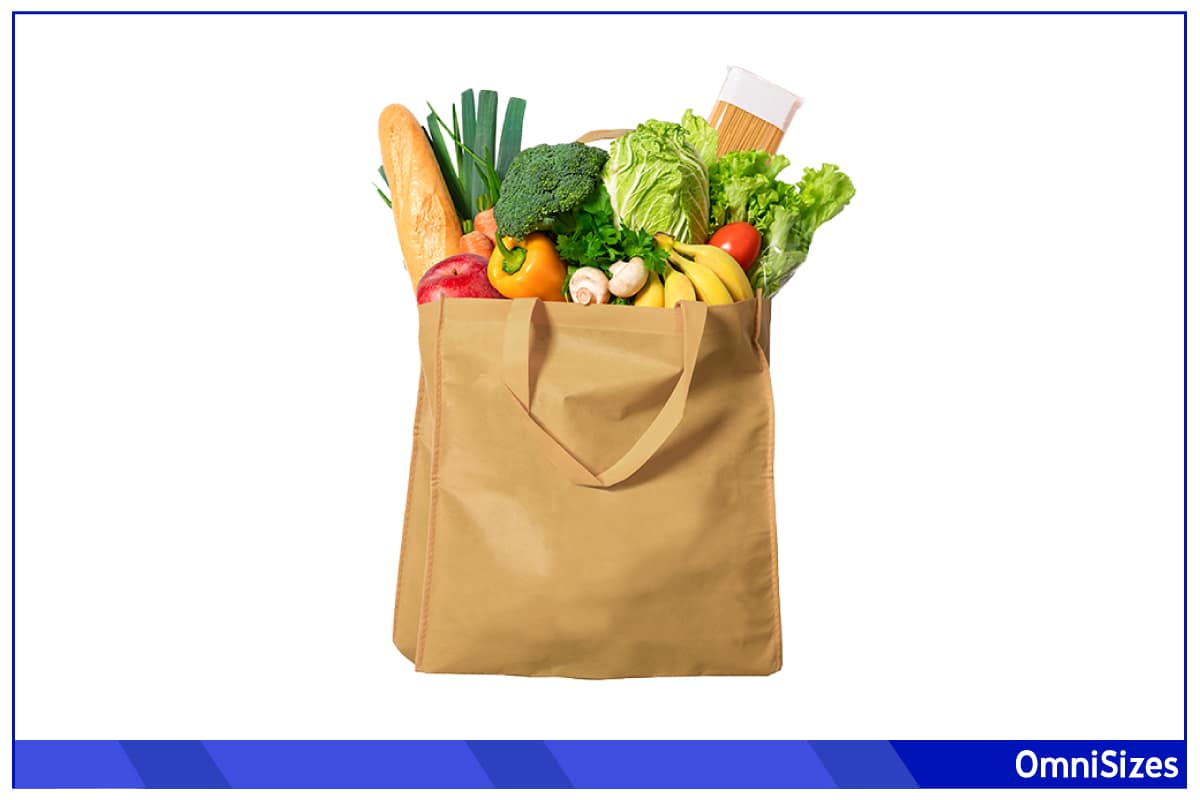Shopping for groceries is a routine part of the line. However, the bags, as important as they are, often go overlooked. The topic of grocery bag sizes, which encompasses dimensions, materials, and purpose, is more intriguing than it appears initially. From small handheld bags to large reusable ones, there’s a lot we can learn about these everyday objects.
Grocery bags come in a wide range of sizes, with the typical bag measuring 16 × 22 inches (56 × 40 cm). When filled, it can measure 6 inches (15 cm) deep. Single-use grocery bags have been replaced with reusable bags made of fabric, which measure around 13 × 15.5 × 7 inches (33 × 39 × 18 cm) with 15-inch-long (38 cm) handles.
This guide will cover the various types of grocery bags and their dimensions, how to choose the right bag and practical tips.
Grocery Bag Types and Sizes
The type of grocery bag you receive depends on where you shop. Here, you can learn about the sizes of common grocery bags and their uses.
1. Paper Grocery Bags
Paper bags are a common choice in grocery stores. Typically, they are available in sizes like small (6 × 11 × 3.5 inches), medium (7 × 13 × 4.5 inches), and large (12 × 17 × 7 inches). These dimensions offer flexibility for different shopping volumes. Kraft paper bags are favored for their biodegradability and recyclability, but they lack the durability of other types.
2. Plastic Grocery Bags
Plastic bags are lightweight and waterproof, making them a popular choice for many shoppers. Standard sizes are approximately 16 × 22 inches and measure around 6 inches wide when filled. Despite their convenience, there’s growing concern over their environmental impact, which has led to reduced usage and bans in some areas.
3. Reusable Grocery Bags
Reusable bags are increasingly popular due to their durability and eco-friendliness. Common materials include cloth, canvas, and recycled plastics. These bags come in varied sizes, with typical dimensions around 13 × 20 inches, offering more strength than single-use bags. They are ideal for heavy or bulky items and can be used repeatedly.
4. Insulated Grocery Bags
Insulated bags are designed to maintain temperature, making them perfect for transporting frozen or hot items. They usually measure around 13 × 14 × 8 inches and provide ample space for temperature-sensitive groceries. These bags are a must-have for shoppers who travel long distances from the store or in extreme weather conditions.
Choosing the Right Grocery Bag Size
Since many shopping areas will sell you overpriced shopping bags due to “plastic bans,” your best option is to take grocery bags with you. The only question is, what size should you get?
1. Assess Routine Shopping Habits
Start by evaluating your typical grocery shopping habits. Are you shopping for a single meal, a week’s worth of groceries, or bulk items? Smaller bags, around 6 × 11 inches, are sufficient for daily essentials, while larger bags, approximately 16 × 22 inches or more, are better for weekly shopping or bulk purchases.
2. Prepare a Bag for Daily Errands
For quick trips or when buying only a few items, compact and foldable bags are ideal. These typically measure around 10 × 15 inches (folded dimensions) and can easily fit into a purse or a pocket. They’re also great for unplanned purchases without excess bulk.
3. Choosing Sizes for Specialized Items
Specialized grocery items like wine, bread, or delicate produce may require specific bag types. Wine bags usually have compartments measuring around 8 × 14 × 3.5 inches to protect bottles, while bread and produce bags are often softer and breathable, sized to protect and preserve their contents.
4. Durability and Material
The material of the bag impacts its size and durability. Cloth and canvas bags are sturdy and can carry more weight compared to plastic or paper bags. For heavier items, choosing a stronger material ensures that the bag can hold the weight without tearing.
Practical Tips for Grocery Bags
Effectively using grocery bags can make your shopping trips more efficient and eco-friendlier. Here are some practical tips to get the most out of your grocery bags, regardless of their size or type.
1. Maximizing Space in Your Bag
- Organizing Items: Start by placing heavier items at the bottom. This provides a stable base and prevents damage to delicate items.
- Balancing Weight: Distribute weight evenly in each bag to make carrying easier and prevent bag breakage.
- Utilizing Corners: Place small, sturdy items in the corners of the bag to maximize space.
- Avoiding Overfilling: Overfilling can lead to breakage and is less eco-efficient. Use multiple bags if necessary.
2. Efficient Packing Techniques
- Category Packing: Pack similar items together (e.g., frozen foods, cleaning supplies) for easy unpacking.
- Using Reusable Containers: For bulk items or loose produce, use reusable containers to reduce waste and organize better.
- Bag-in-Bag Method: Place a smaller bag inside a larger one for extra support with heavy or sharp items.
3. Caring for Your Grocery Bags
- Cleaning Tips: Regularly clean your bags, especially reusable ones. Machine-wash cloth bags and wipe down plastic or insulated bags with a disinfectant.
- Storage Solutions: Store your bags in a cool, dry place. Fold or roll them neatly for compact storage.
- Regular Inspection: Check for wear and tear, especially in areas like handles and seams. Repair minor damages or replace bags when necessary.
4. Reducing Environmental Impact
- Recycling Single-Use Bags: Properly recycle plastic and paper bags when they can’t be reused.
- Opting for Eco-Friendly Materials: Choose bags made from recycled or sustainable materials.
- Long-Term Use: Invest in high-quality reusable bags that will last longer and reduce the need for single-use bags. While splurging on grocery bags may sound like a burden, the extra effort can go a long way in the fight against wastage.






